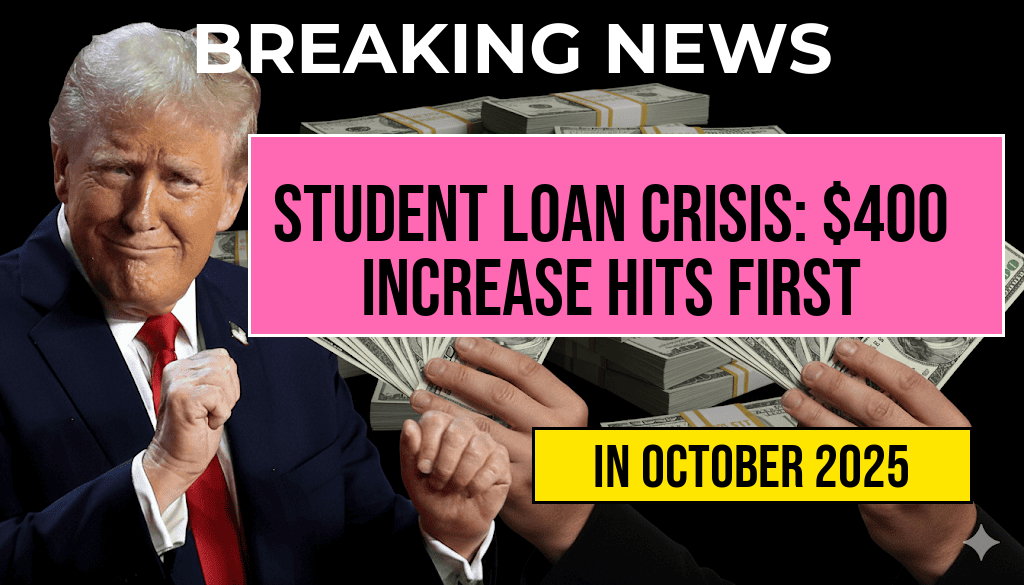Student Loan Payments Set to Surge by $400 Monthly for Millions of Borrowers
A recent federal policy shift is poised to dramatically increase monthly student loan payments for millions of borrowers, with some facing hikes of up to $400. This change stems from the expiration of pandemic-era relief measures and adjustments in interest rates and repayment plans. While the exact impact varies depending on individual loan balances and repayment strategies, early estimates suggest that a significant portion of borrowers could see their monthly bills double or even triple.
Those most immediately affected are borrowers with the largest balances, particularly recent graduates and individuals who have deferred or paused payments during the COVID-19 crisis. This demographic, often facing tight budgets and rising living costs, now confronts a substantial financial adjustment. Advocacy groups warn that such increases could trigger widespread financial strain, potentially leading to missed payments and further debt complications.
Meanwhile, policymakers and financial analysts are scrutinizing the potential ripple effects on the economy, emphasizing the importance of targeted relief measures and flexible repayment options. As the countdown to the resumption of regular payments continues, understanding who will be affected first and how this shift will reshape borrower experiences remains crucial.
Background: The End of Pandemic-Related Relief Measures
During the height of the COVID-19 pandemic, federal student loan borrowers benefited from a series of relief measures, including a pause on payments, 0% interest accrual, and suspension of collections on defaulted loans. These policies provided temporary financial breathing room amid economic uncertainty. However, with the expiration of these measures beginning in 2023, borrowers are now facing the reactivation of standard repayment obligations.
The Department of Education announced that as of October 2023, payments would resume in full, with interest rates returning to pre-pandemic levels. For many, this means a substantial increase in their monthly financial commitments, especially for those with large principal balances or variable interest rate loans.
Who Will Be Affected First?
| Borrower Category | Estimated Monthly Increase | Number of Affected Borrowers | Key Factors |
|---|---|---|---|
| Recent Graduates with Large Balances | Up to $400 | Approximately 10 million | High balances, minimal savings, tight budgets |
| Borrowers on Income-Driven Repayment Plans | Varies; often less than $200, but increases possible as plans are recalibrated | About 8 million | Adjusted monthly payments after recalculation |
| Delinquent or Defaulted Borrowers | Potentially higher due to interest accrual | Estimated 2 million | Accumulated interest and penalties |
Factors Contributing to Payment Increases
- Interest Rate Adjustments: Many federal loans have variable interest rates that are rising in tandem with market benchmarks, leading to higher accruing interest and larger monthly payments.
- Repayment Plan Recalculations: Borrowers on income-driven plans may see their payments increase as income calculations and forgiveness thresholds are revised.
- Loan Balance Size: Larger principal balances translate directly into higher monthly payments once repayment resumes at standard rates.
Potential Financial and Economic Impacts
The looming payment hikes could strain household budgets, especially for borrowers already managing multiple financial obligations. Experts warn that the increase might push some to struggle with mortgage, rent, or utility payments, raising the risk of missed student loan payments and defaults.
A report from the Federal Reserve suggests that defaulting on student loans can have long-term impacts on credit scores, employment prospects, and financial stability. For younger borrowers, these disruptions can ripple into delayed milestones such as homeownership or starting a family.
Moreover, widespread repayment difficulties could influence economic activity, as reduced disposable income limits consumer spending. Some analysts argue that targeted relief programs, such as extended repayment options or income-based adjustments, could mitigate negative fallout.
Policy Responses and Borrower Options
The Department of Education has emphasized that borrowers will receive detailed notices before payments restart and encouraged those facing hardship to explore income-driven repayment plans or deferment options. Some advocates advocate for additional relief measures, including temporary payment caps or forgiveness programs, to cushion the immediate impact.
Borrowers can review their repayment options through the Federal Student Aid website (studentaid.gov) to determine eligibility for income-based plans or forbearance. Financial advisors recommend borrowers proactively communicate with their loan servicers to navigate upcoming changes and avoid default.
Looking Ahead: Preparing for the Transition
As millions brace for higher monthly student loan payments, experts stress the importance of early planning. Establishing a budget that incorporates the increased payments, exploring repayment options, and seeking financial counseling can help mitigate stress.
Policy analysts continue to debate the long-term implications of the payment hikes, with some calling for permanent reforms to make student debt more manageable. Meanwhile, borrowers are urged to stay informed through official channels and to act promptly if financial hardship arises.
For more information on student loan repayment options and assistance programs, visit studentaid.gov.
Frequently Asked Questions
What is the main cause of the recent increase in student loan payments?
The recent student loan payment increase is primarily due to policy changes that are affecting loan repayment terms and interest rates, impacting millions of borrowers nationwide.
Who will be the first group to experience the $400 monthly payment increase?
The first group affected will typically include borrowers with longer repayment periods and higher outstanding balances, especially those nearing the end of their grace period.
How will the increase impact borrowers’ financial stability?
The $400 increase can significantly strain borrowers’ monthly budgets, potentially leading to difficulty in meeting other financial obligations and increasing the risk of delinquency or default.
Are there any options available to mitigate or reduce the increased payments?
Yes, borrowers may consider income-driven repayment plans, deferment, or forbearance options to manage their monthly payments during financial hardship.
What should affected borrowers do to prepare for these payment changes?
Borrowers should review their loan details, contact their loan servicers, and explore repayment options to ensure they are adequately prepared for the upcoming increase in payments.

Leave a Reply